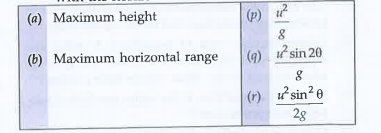If at any instant the velocity of a projectile be u and its direction of motion θ to the horizon then it will be moving at right angles to this direction, after time ugcosecθ
The correct Answer is:T
To solve the problem, we need to show that if at any instant the velocity of a projectile is u and its direction of motion makes an angle θ with the horizontal, then it will be moving at right angles to this direction after a time ugcscθ.
1. Initial Velocity Components:
The initial velocity u can be resolved into two components:
- Horizontal component: ux=ucosθ
- Vertical component: uy=usinθ
2. Velocity After Time t:
After a time t, the horizontal velocity remains constant since there is no horizontal acceleration:
- vx=ucosθ
The vertical velocity changes due to the acceleration due to gravity g:
- vy=uy−gt=usinθ−gt
3. Velocity Vector After Time t:
The velocity vector after time t can be expressed as:
v=vx^i+vy^j=ucosθ^i+(usinθ−gt)^j
4. Condition for Perpendicularity:
For the two velocity vectors to be perpendicular, their dot product must be zero:
vi⋅v=0
where vi=ucosθ^i+usinθ^j.
5. Calculating the Dot Product:
The dot product is calculated as follows:
(ucosθ)(ucosθ)+(usinθ)(usinθ−gt)=0
Expanding this gives:
u2cos2θ+u2sin2θ−ugtsinθ=0
6. Using Trigonometric Identity:
Using the identity cos2θ+sin2θ=1:
u2−ugtsinθ=0
7. Solving for Time t:
Rearranging gives:
ugtsinθ=u2
Thus,
t=ugsinθ
8. Final Expression:
We can express sinθ as cscθ:
t=ugcscθ
This shows that after the time ugcscθ, the projectile will be moving at right angles to its initial direction of motion.
The initial velocity u can be resolved into two components:
- Horizontal component: ux=ucosθ
- Vertical component: uy=usinθ
After a time t, the horizontal velocity remains constant since there is no horizontal acceleration:
- vx=ucosθ
- vy=uy−gt=usinθ−gt
The velocity vector after time t can be expressed as:
v=vx^i+vy^j=ucosθ^i+(usinθ−gt)^j
For the two velocity vectors to be perpendicular, their dot product must be zero:
vi⋅v=0
where vi=ucosθ^i+usinθ^j.
The dot product is calculated as follows:
(ucosθ)(ucosθ)+(usinθ)(usinθ−gt)=0
Expanding this gives:
u2cos2θ+u2sin2θ−ugtsinθ=0
Using the identity cos2θ+sin2θ=1:
u2−ugtsinθ=0
Rearranging gives:
ugtsinθ=u2
Thus,
t=ugsinθ
We can express sinθ as cscθ:
t=ugcscθ
Similar Questions
Knowledge Check
A particle is projected with a velocity of 39.2m/sec at an angle of 30∘ to the horizontal. It will move at right angles to the direction of projection after the time
A8 secB5 secC6 secD10 secThe angle of which the velocity vector of a projectile thrown with a velocity u at an angle θ to the horizontal will take with the horizontal after time t of its being thrown up is
AθBtan−1(θt)Ctan−1(vcosθvsinθ−gt)Dtan−1(vsinθ−gtvcosθ)A particle is projected from a point P with a velocity v at an angle θ with horizontal. At a certain point Q it moves at right angles to its initial direction. Then
AVelocity of particle at Q is vsinθBVelocity of particle at Q is vcotθCTime of flight from P to Q is (v/g)cosecθDTime of flight from P to Q is (v/g)secθ
A ball is projected with initial speed u at an angle θ above the horizontal . Calculate the time after which ball will be moving at right angle to its initial velocity.
View SolutionA projectile at any instant during its flight has velocity 5ms−1 at 30∘ above the horizontal.How long after this instant,will it be moving at right angle to the given direction.
View SolutionA projectile is projected with velocity u making angle θ with horizontal direction, find : horizontal range.
View SolutionA particle moving with velocity V changes its direction of motion by an angle θ without change in speed. Which of the following Statement is not correct?
View SolutionIf θ is the angle between the velocity and acceleration of a projectile at a point of its path, its value when the projectile is at the highest point is :
View Solution

